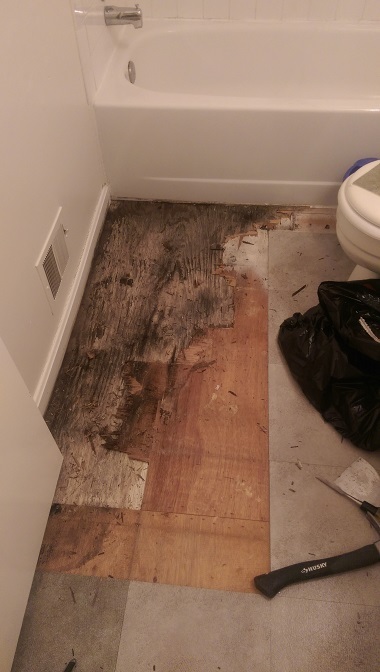Each person has their own conception about Common Causes of Water Damage in a Bathroom.

The restroom is very prone for wet buildup and potential water damage due to the frequent use of water in it. This article supplies simple examination techniques to help discovering water damage risks.
The regular use water in the restroom makes it very at risk for moist accumulation and possible water damages. By examining it frequently, you can minimize water relevant problems.
The complying with set of assessments is simple to do and need to be done once in every 3 months in order to maintain your shower room in good shape and to prevent potential water problems brought on by the bath tub, the shower, pipeline joints and also plumbing, sinks, closets, and the toilet
Do not neglect performing these inspections and also be complete while doing them. Bear in mind that these straightforward evaluations can save you a great deal of money by providing very early indications for water damages
Bath tub and Shower
The shower and bathtub require unique interest and upkeep. Examine the ceramic tiles and replace if split. Make certain that there is no missing grout in between the floor tiles. Examine and change broken caulking at joints where the wall surfaces satisfy the floor or the bathtub. Obstructed drains pipes and pipelines issues will prevent the bath tub from drying out as well as may indicate significant troubles below the bathtub. Seek advice from an expert promptly to prevent architectural damage. Take note of stainings or soft locations around the bathtub wall surfaces as they might suggest an internal leakage.
Plumbing
Signs for water damages are difficult to identify considering that many pipes are installed inside the wall surfaces.
Pay special interest to flooring and wall surfaces moisture as well as stains as they may show an undetectable plumbing trouble. Inspect dampness degrees in adjoining areas as well.
Sinks and also Cabinets
Sinks and cupboards are exposed to dampness and also humidity everyday and also are commonly overlooked. Inspect frequently under the sink and on the counter top above it. Fix any drip in the catch as it might recommend drainpipe issues. Browse the sink, slow-moving draining pipes may indicate an obstructed drainpipe. Replace sink seals if they are fractured or loosened.
The Commode
The commode is a susceptible water joint. Check the water lines and also look for leakages around the commode seat, in the tube, and under the water container. If you spot any type of indications of dampness on the flooring around the toilet, check for leaks in the toilet edge as well as storage tank seals.
Be aware that hanging toilet dish deodorants boosts the opportunities for clogs.
10 TIPS TO PREVENT WATER DAMAGE IN THE BATHROOM
The average household uses approximately 80-100 gallons of water per person per day. For a family of 4, that's almost 2,500 gallons of water a week! The largest portion of this consumption comes from bathroom use. Flushing the toilet uses the most water, followed by taking a shower or bath. With that much water running through the home, water damage in the bathroom is bound to happen. Knowing how to spot signs of a water leak is essential to preventing long-term damage. This guide provides you with tips to reduce the impact of water damage on your bathroom.
CAUSES OF BATHROOM WATER DAMAGE
Pipe breaks are the most common cause of water damage we see in our daily jobs. The age of a pipe plays a large role in a pipe break as well as corrosion. Over time, the metal begins to break down, allowing water to escape. Frozen pipe breaks are also a concern in the winter months. Toilet overflows caused by paper products or children flushing inappropriate items. Degraded caulking around the toilet or bathtub can allow water seepage, sometimes behind the fixture, into the subfloor or walls. Condensation forms when the water in a pipe is cooler than the air temperature. Beads of water form on the exterior of the pipes, sometimes so much so that the water begins to drip and pool below. Sink or shower backups created by poor drainage. HOW TO PREVENT WATER DAMAGE IN YOUR BATHROOM
Inspect your toilet supply line for worn or frayed hoses and replace them as needed. Winterize your plumbing to prevent a frozen pipe break. Use vent fans to prevent condensation that can lead to mold growth. Routinely check and replace degraded caulking around your toilet or bathtub. Increase the temperature in your toilet tank and insulate your pipes during the warm summer months to keep condensation from forming. Use child safety locks on the toilets. Flush only toilet paper. "Flushable" wet wipes are actually not good for your plumbing system. Additionally, feminine hygiene products should not be flushed. Prevent water from escaping the tub or shower. Make sure shower curtains are in good condition. Inspect shower doors and replace the seal strip if necessary. Wipe up any water that accumulates on the floor and use bath mats. Water left to sit can cause damage to the tiles and flooring. Refrain from using bath products containing heavy oils to avoid a clogged drain.

I recently found that content on How to Fix a Water Damage Bathroom when doing a lookup on the internet. Loved our content? Please share it. Help other people find it. I enjoy reading our article about How to Fix a Water Damage Bathroom.
Article